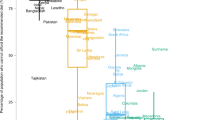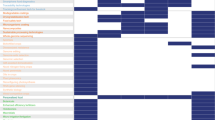Abstract
Global food system analyses call for an urgent transition to sustainable human diets but how this might be achieved within the current global food regime is poorly explored. Here we examine the factors that have fostered major dietary shifts across eight countries in the past 70 years. Guided by transition and food-regime theories, we draw on data from diverse disciplines, reviewing post-World War 2 shifts in consumption of three food commodities: farmed tilapia, milk and chicken. We show that large-scale shifts in commodity systems and diets have taken place when public-funded technological innovation is scaled-up by the private sector under supportive state and international policy regimes, highlighting pathways between commodity systems transformation and food-system transitions. Our analysis suggests that the desired sustainability transition will require public policy leadership and private-sector technological innovation alongside consumers who culturally value and can afford healthy, sustainable diets.
This is a preview of subscription content, access via your institution
Access options
Access Nature and 54 other Nature Portfolio journals
Get Nature+, our best-value online-access subscription
$29.99 / 30 days
cancel any time
Subscribe to this journal
Receive 12 digital issues and online access to articles
$119.00 per year
only $9.92 per issue
Buy this article
- Purchase on Springer Link
- Instant access to full article PDF
Prices may be subject to local taxes which are calculated during checkout




Similar content being viewed by others
Data availability
Quantitative data for this Article are available publicly through the FAO. The qualitative data are described in the Supplementary Information.
References
Vermeulen, S. et al. Changing Diets and Transforming Food Systems Working Paper No. 282 (CCAFS, 2019).
IPCC Climate Change and Land: IPCC Special Report on Climate Change, Desertification, Land Degradation, Sustainable Land Management, Food Security, and Greenhouse Gas Fluxes in Terrestrial Ecosystems (eds Masson-Delmotte, V. et al.) (WMO, 2019).
Willett, W. et al. Food in the Anthropocene: the EAT–Lancet Commission on healthy diets from sustainable food systems. Lancet 393, 447–492 (2019).
Springmann, M. et al. Options for keeping the food system within environmental limits. Nature 562, 519–525 (2018).
Poore, J. & Nemecek, T. Reducing food’s environmental impacts through producers and consumers. Science 360, 987–992 (2018).
Gouel, C. & Guimbard, H. Nutrition transition and the structure of global food demand. Am. J. Agric. Econ. 101, 383–403 (2019).
Pastor, A. V. et al. The global nexus of food–trade–water sustaining environmental flows by 2050. Nat. Sustain. 2, 499–507 (2019).
Branca, F. et al. Transforming the food system to fight non-communicable diseases. BMJ 364, l296 (2019).
Swinburn, B. A. et al. The global syndemic of obesity, undernutrition, and climate change: the Lancet Commission report. Lancet 393, 791–846 (2019).
Steyn, N. P. & Mchiza, Z. J. Obesity and the nutrition transition in sub‐Saharan Africa. Ann. NY Acad. Sci. 1311, 88–101 (2014).
Hirvonen, K., Bai, Y., Headey, D. & Masters, W. A. Affordability of the EAT–Lancet reference diet: a global analysis. Lancet Glob. Health 8, e59–e66 (2020).
Geels, F. W. Technological transitions as evolutionary reconfiguration processes: a multi-level perspective and a case-study. Res. Policy 31, 1257–1274 (2002).
Friedman, H. & McMichael, P. The rise and decline of national agricultures, 1870 to the present. Sociol. Ruralis 29, 93–117 (1989).
Geels, F. W. From sectoral systems of innovation to socio-technical systems: insights about dynamics and change from sociology and institutional theory. Res. Policy 33, 897–920 (2004).
Smith, A., Stirling, A. & Berkhout, F. The governance of sustainable socio-technical transitions. Res. Policy 34, 1491–1510 (2005).
McMichael, P. & Friedmann, H. Agriculture and the state system: the rise and decline of national agriculture. 1870 to the present. Sociol. Ruralis 29, 93–117 (1989).
Markard, J., Raven, R. & Truffer, B. Sustainability transitions: an emerging field of research and its prospects. Res. Policy 41, 955–967 (2012).
Stamoulis, K., Pingali, P. & Prakash. Emerging challenges for food and nutrition policy in developing countries. Electron. J. Agric. Dev. Econ. 1, 154–167 (2004).
Springmann, M. et al. The healthiness and sustainability of national and global food based dietary guidelines: modelling study. BMJ 370, m2322 (2020).
Godfray, H. C. J. et al. Meat consumption, health, and the environment. Science 361, eaam5324 (2018).
Ostrom, E. & Cox, M. Moving beyond panaceas: a multi-tiered diagnostic approach for social-ecological analysis. Environ. Conserv. 37, 451–463 (2010).
Glouberman, S. & Zimmerman, B. Complicated and complex systems: what would successful reform of Medicare look like? Rom. Pap. 2, 21–53 (2002).
Alders, R. G. et al. Family poultry: multiple roles, systems, challenges, and options for sustainable contributions to household nutrition security through a planetary health lens. Matern. Child Nutr. 14, e12668 (2018).
Aizawa, T. Transition of the BMI distribution in India: evidence from a distributional decomposition analysis. J. Bioeconomics 21, 3–36 (2019).
Adesogan, A. T., Havelaar, A. H., McKune, S. L., Eilittä, M. & Dahl, G. E. Animal source foods: sustainability problem or malnutrition and sustainability solution? Perspective matters. Glob. Food Sec. 25, 100325 (2019).
McMichael, A. J., Powles, J. W., Butler, C. D. & Uauy, R. Food, livestock production, energy, climate change, and health. Lancet 370, 1253–1263 (2007).
Hammond, R. A. & Dubé, L. A systems science perspective and transdisciplinary models for food and nutrition security. Proc. Natl Acad. Sci. USA 109, 12356–12363 (2012).
McMichael, P. Food Regimes and Agrarian Questions (Fernwood, 2013).
Food and Nutrition Security for All through Sustainable Agriculture and Food Systems (UN System High Level Task Force on Global Food Security, 2012).
A Sustainable Food System for the European Union (Science Advice for Policy by European Academics, 2020).
Roberts, C. & Geels, F. W. Conditions for politically accelerated transitions: historical institutionalism, the multi-level perspective, and two historical case studies in transport and agriculture. Technol. Forecast. Soc. Change 140, 221–240 (2019).
Morrissey, J. E., Mirosa, M. & Abbott, M. Identifying transition capacity for agri-food regimes: application of the multi-level perspective for strategic mapping. J. Environ. Policy Plan. 16, 281–301 (2014).
Mylan, J., Morris, C., Beech, E. & Geels, F. W. Rage against the regime: niche-regime interactions in the societal embedding of plant-based milk. Environ. Innov. Soc. Transitions 31, 233–247 (2019).
Benedetti, I., Laureti, T. & Secondi, L. Choosing a healthy and sustainable diet: a three-level approach for understanding the drivers of the Italians’ dietary regime over time. Appetite 123, 357–366 (2018).
Kuokkanen, A. et al. Agency in regime destabilization through the selection environment: the Finnish food system’s sustainability transition. Res. Policy 47, 1513–1522 (2018).
Pritchard, B., Dixon, J., Hull, E. & Choithani, C. ‘Stepping back and moving in’: the role of the state in the contemporary food regime. J. Peasant Stud. 43, 693–710 (2016).
Wellesley, L., Happer, C. & Froggat, A. Changing Climate, Changing Diets. Pathways to Lower Meat Consumption (Chatham House, 2015).
Bui, S., Cardona, A., Lamine, C. & Cerf, M. Sustainability transitions: insights on processes of niche–regime interaction and regime reconfiguration in agri-food systems. J. Rural Stud. 48, 92–103 (2016).
Mytton, O. T., Clarke, D. & Rayner, M. Taxing unhealthy food and drinks to improve health. BMJ 344, e2931 (2012).
Béné, C. et al. When food systems meet sustainability—current narratives and implications for actions. World Dev. 113, 116–130 (2019).
Garlock, T. et al. A global blue revolution: aquaculture growth across regions, species, and countries. Rev. Fish. Sci. Aquac. 28, 107–116 (2020).
Geels, F. W. The multi-level perspective on sustainability transitions: responses to seven criticisms. Environ. Innov. Soc. Transitions 1, 24–40 (2011).
Acknowledgements
This work was funded by a grant from The Rockefeller Foundation to WWF and was supported through a partnership with the National Center for Ecological Analysis and Synthesis. We thank all members of their partnership for their feedback on early drafts of this work. E.A. was also supported by a visiting professorship at ANCORS, University of Wollongong, Australia, the Nippon Foundation Ocean Nexus Program and the CGIAR research programme on fish agrifood systems (FISH). L.V.R. was funded by the European Research Council under the European Union’s Horizon 2020 research and innovation programme (grant agreement number 853222 FORESTDIET).
Author information
Authors and Affiliations
Contributions
All authors contributed to the conceptual development and writing of this manuscript. H.K.H. led the background literature review along with T.A., M.A., C.S. and E.M. E.M. and H.K.H. produced the figures. E.H.A., B.S.H. and E.M. led the writing of the manuscript. E.H.A., J.D. and B.S.H. led the conceptual framing.
Corresponding author
Ethics declarations
Competing interests
The authors declare no competing interests.
Additional information
Peer review information Nature Food thanks Lindsay Jaacks and the other, anonymous, reviewer(s) for their contribution to the peer review of this work.
Publisher’s note Springer Nature remains neutral with regard to jurisdictional claims in published maps and institutional affiliations.
Supplementary information
Supplementary Information
Supplementary methods, notes, and references. This section contains review methodology, narrative case study results, and analysis of substitution and additions to country diets.
Supplementary Table
Table containing an alternative format of the information from Figs. 2–4 summarizing the case study results by driver.
Rights and permissions
About this article
Cite this article
Moberg, E., Allison, E.H., Harl, H.K. et al. Combined innovations in public policy, the private sector and culture can drive sustainability transitions in food systems. Nat Food 2, 282–290 (2021). https://doi.org/10.1038/s43016-021-00261-5
Received:
Accepted:
Published:
Issue Date:
DOI: https://doi.org/10.1038/s43016-021-00261-5
This article is cited by
-
Effects of public policy interventions for environmentally sustainable food consumption: a systematic map of available evidence
Environmental Evidence (2024)
-
Towards a nutritional balance of fish for feed and fish for food
Nature Food (2024)
-
Mapping lock-ins and enabling environments for agri-food sustainability transitions in Europe
Sustainability Science (2024)
-
Transforming the food system in ‘unprotected space’: the case of diverse grain networks in England
Agriculture and Human Values (2024)
-
Public authorities for transformative change: integration principle in public funding
Biodiversity and Conservation (2023)



